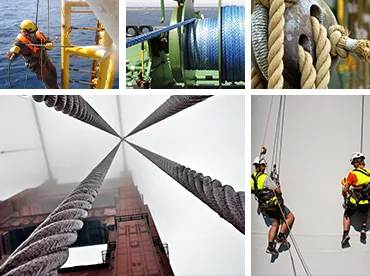Why Use Nylon Rope in Rock Climbing?
Nowadays, climbing ropes are elastic and do not break when used correctly. This was not always the case. Until the 1950's/60's climbing ropes were mainly made of hemp or other non-elastic fibers.
Nowadays, climbing ropes are elastic and do not break when used correctly. This was not always the case. Until the 1950's/60's climbing ropes were mainly made of hemp or other non-elastic fibers. In those days there was one rule of rock climbing: don't fall! Ropes without elasticity could break if they were subjected to too much pressure. It was also unpleasant to slow down suddenly in the fall. If the rope was held, the consequence was injury and possibly death from the length of the fall. Today, climbing ropes are made of nylon, elastic plastic or synthetic fibers. Nylon does not tear and is flexible. This slows falls over longer distances than static ropes, significantly reducing the forces on the body, rope and safety equipment. Therefore, it is now normal to fall while climbing because the fall is harmless due to the better, elastic rope. Another advantage of elastic nylon climbing rope is that anchors and other anchorages cannot be torn off as easily as fast static tensions.
The tensile strength of climbing rope
Since climbing rope is safety equipment, it is subject to strict regulations and must have certain performance. One of the most important characteristics of climbing rope is of course its tensile strength. Tensile strength is not measured by the maximum force that will cause a tear, but by the number of standardized falls that the rope can withstand. The fall is made from a certain height with a certain weight and deflected by a climbing buckle. The end of the rope is fixed, which makes the fall is stationary. Such a fall with so much pressure does not occur during normal climbing. Worst case scenarios are always used for safety related testing.
An ordinary climbing rope must go through 5 such falls before it breaks. There are also so-called multiple fall ropes that must withstand at least 10 falls.
Climbing ropes do not break in normal use. Rope breakage accidents can always be traced back to a damaged rope. Always make sure that the rope is not guided over a sharp edge. If a climbing rope rubs against a sharp edge due to the force of a falling person, it can be damaged and in the worst case will tear.
Dynamic vs. static ropes
To avoid confusion, this section will explain the difference between dynamic and static climbing ropes. Dynamic climbing ropes (up to 40% extension) are used whenever you hang from the rope infrequently and only use it for fall protection. However, if the rope is under tension most of the time and is the main component of the activity, a static rope (only stretches up to 5%) is more appropriate.
Applications for static ropes include rappelling/speed rappelling, mountain rescue, and canyoning.
These activities are well suited for static ropes. You are always hanging on to the rope and it stretches all the time. With a kinetic climbing rope, you get the feeling of hanging on a rubber band. This will be very difficult especially during the ascent.
Length and diameter
Dynamic climbing ropes come in many different lengths and diameters. Most climbing ropes are 40 to 70 meters long. For particularly long distances, there are also ropes 80 to 100 meters long.
If you are only climbing indoors in a climbing gym, a short rope (around 40 meters) will suffice. If you like to climb outdoors, you should be equipped with 60 meters of climbing rope. You can use it to cover a lot of things. If you know in advance how high the rock face is, you can better adjust the rope to suit the conditions.
The diameter of climbing rope is between 8.3 and 11.5 mm. The thinner the climbing rope, the less it can take a fall and the more vulnerable it is to other damage. Thicker climbing ropes are stronger and more durable, but they are also heavier.
Beginners should definitely start in the upper-middle range of about 10 to 10.5 mm. This diameter is sturdy and durable and offers very good maneuverability.

Care and maintenance of climbing ropes
To extend the life of your climbing rope and ensure its long-term safety, here are some basic tips.
1. After a climb, the first and last 2-3 meters of the climbing rope should be cleaned with a brush. This extends its service life as dirt, pins, dust and especially climbing chalk are removed.
2. Climbing rope should never be thrown on the bare ground. There should always be a protective layer between the ground and the rope. A piece of fabric, tarp or rope bag is perfect for this situation. Climbing rope should be exposed to as little dust, sharp stones and other dirt as possible to prolong its life. Crystallized, sharp-edged dirt gets between the single fibers, just like sandpaper. Due to the friction between the stretch rope and the dust, the fibers are permanently rubbed off and lose their strength.
3. Climbing ropes must be protected from chemicals and acids. These may damage the rope from the inside, and this situation is especially serious because it cannot be seen with the naked eye, such as mechanical damage.
4. You should never step on the rope. In addition to cutting the rope by pressing on the sharp edges, you can also use your feet to press dirt and dust into the rope's sheath. This can lead to damage inside the climbing rope that cannot be seen.
5. Always change edges between climbs. The fall load and other stresses during climbing have different effects on the two ends of the rope. To evenly distribute this stress and increase the general service life, the ends of the rope should be exchanged on each climb.
6. Clean the rope occasionally. Yes, if you consider something, you can clean the climbing rope. The water may be only slightly warm, never hot. You should use special detergent to clean the climbing rope. Climbing ropes can be washed by hand or in the washing machine. Washing machines should not be operated at temperatures above 30°C and should be run on the wool or fine wash cycle. If washing by hand, pay special attention to both ends. Climbing ropes must be dried in the air. It is important to ensure that the rope is not exposed to direct sunlight, as UV rays can damage the fibers in the rope.
7. If the rope is not in use, it should be stored in a cool, dry place away from light. Rope bags are great for storage. Most rope bags can be carried comfortably as a bag or backpack and are ideal for protecting the rope.
When to Retire a Rock Climbing Rope
The lifespan of a rock climbing rope depends significantly on how it is cared for and, of course, how often it is used.
Manufacturers are required to make a statement about the lifespan. With good care and within this time, the manufacturer guarantees proper function. Here are the usual recommendations for the lifespan of climbing ropes:
|
Frequency of use |
Recommended period of use |
|
never |
10 years |
|
1-2 times a year |
7 years |
|
monthly |
5 years |
|
several times a month |
3 years |
|
once a week |
1 year |
|
almost daily |
less than 1 year |
For private use, this generous life expectancy information can be considered a best before date. Exceeding the recommended service life will not automatically cause the rope to fail, but over time, properties such as stretching and handling will become worse and worse. You must decide for yourself when to dispose of the climbing rope.
Conclusion
Climbing ropes are made of nylon and are therefore flexible and strong. A nylon climbing rope can stretch up to 40% and gently catch a falling climber. The load on climbers, ropes and other safety equipment is thus minimized.
Climbing ropes are designed to withstand many heavy falls during their service life. Today, climbing ropes only break in the very unfortunate event that they are pulled over a sharp edge during a fall or have been severely damaged.
When choosing a climbing rope, be sure to choose the length and thickness. For beginners, we recommend 40 meters for indoor climbing and 60 meters for outdoor climbing. The diameter should be approximately 10 to 10.5 mm.
If you pay attention to some things during use and storage, you will have a good time.
